Watermelon is a beloved summertime fruit, but its large size can be challenging for those with limited space or smaller refrigerators. Fortunately, there are several delightful varieties of small fruit that resemble watermelon in appearance and taste. These small fruit options like watermelon are perfect for satisfying your cravings while fitting into your compact living space.
Key Takeaways:
- Small fruit alternatives resembling watermelon offer a refreshing taste in a more compact size.
- Miniature watermelon-like fruits like cucamelons are a popular option with a cucumber flavor.
- Growing mini melons vertically can save space and create an aesthetically pleasing garden.
- Queen Anne’s Pocket Melon is known for consistently producing the tiniest watermelon-like fruits.
- Explore a variety of mini melon options to satisfy your watermelon cravings.
Cucamelons: The Lilliputian Watermelons
One popular small fruit similar to watermelon is the cucamelon. Cucamelons are grape-sized fruits that bear a striking resemblance to watermelons, hence their nickname “little watermelon” or “mouse melon”. However, they taste more like cucumbers with a slight lime flavor. Despite their similarities in taste and appearance, cucamelons are not closely related to either cucumbers or watermelons. These tiny fruits are often used in salads, stir-fries, and cocktails, or pickled for a crunchy snack.
These miniature watermelon-like fruit are not only visually appealing but also versatile in their culinary uses. Due to their small size, they make excellent additions to salads, providing a burst of freshness and a unique flavor. Their delicate, cucumber-like taste adds a refreshing twist to stir-fries and cocktails, making them a delightful ingredient for adventurous cooks and mixologists. Additionally, cucamelons can be pickled to create a crunchy and tangy snack, perfect for enjoying on their own or as a garnish.
Cucamelons: How to Grow and Enjoy Them
Growing cucamelons is a rewarding experience, especially if you have limited space or are looking for a watermelon substitute. These small fruit options provide a burst of flavor and can be enjoyed in a variety of ways. Let’s explore how to cultivate and savor the cucamelons.
Growing Cucamelons
To grow cucamelons, you’ll need a warm climate with plenty of sunlight. These mini fruit options thrive in hot weather, so make sure they receive full sun exposure. If you live in an area with a cooler climate, don’t worry! Cucamelons can also be grown in containers, allowing you to enjoy their unique flavors regardless of your local weather conditions.
The best time to plant cucamelon seeds is after the last frost, when the soil has warmed up. Plant the seeds in well-drained soil, and make sure to space them about 12 inches apart. The vines of cucamelons are relatively low maintenance and resistant to both drought and pests, making them an easy addition to your garden.
As your cucamelon plants grow, they will start producing small, grape-sized fruits. You can harvest these mini watermelon-like fruits when they have reached their firm texture, similar to grapes. The vibrant green color and crisp texture make cucamelons a delightful addition to salads, salsas, or enjoyed on their own as a healthy snack.
Enjoying Cucamelons
Cucamelons offer a unique flavor profile that combines the refreshing taste of cucumbers with a hint of tanginess, reminiscent of limes. These small fruit options can be enjoyed in various ways, adding a burst of flavor to your culinary creations. Here are some ideas to savor the cucamelons:
- Raw: Enjoy cucamelons fresh from the vine! Their crisp texture and tangy taste make them a delightful addition to a fruit platter or a healthy snack.
- In salads: Slice cucamelons and toss them into your favorite salads for an interesting twist. Their unique flavor adds a refreshing note to leafy greens or grain-based salads.
- In salsas: Add a tangy kick to your salsas by incorporating cucamelons. Their crispness and tangy flavor blend well with other ingredients, creating a mouthwatering salsa that pairs beautifully with chips or grilled meats.
- As pickles: Cucamelons can be pickled to create a tart and crunchy snack. Simply soak them in a mixture of vinegar, salt, sugar, and your preferred seasonings for a few hours or overnight. The pickled cucamelons can be enjoyed on their own or added to sandwiches and charcuterie boards.
- In cocktails: Cucamelons make a unique addition to cocktails, adding a burst of flavor and visual appeal. Muddle them with herbs and mix them with your favorite spirits to create refreshing and distinctive drinks.
Cucamelons are not only delicious but also packed with nutritional benefits. They are low in calories and provide a healthy dose of vitamins and minerals. Incorporating cucamelons into your diet is a great way to enjoy a small fruit like watermelon while exploring new flavors and culinary possibilities.
| Cucamelons | Nutritional Benefits |
|---|---|
| Vitamin C | Boosts immune system and promotes healthy skin |
| Vitamin K | Supports bone health and blood clotting |
| Potassium | Regulates blood pressure and supports heart health |
| Magnesium | Important for energy production and muscle function |
| Fiber | Aids digestion and promotes feelings of fullness |
Fantastic Mini Melon Varieties
In addition to cucamelons, there are several other mini melon varieties that are perfect for small gardens or vertical growing. These mini melons are characterized by their small size, typically no bigger than 6 inches in width. Some varieties also produce compact, bushy growth instead of long trailing vines. Some popular mini melon options include Sprite Melon, Honey Bun Cantaloupe, Super Ball Melon, and Mini Piccolo Watermelon. These small fruit options provide delicious flavors and can be grown in containers or vertical gardens.
If you’re looking for petite fruit alternatives to watermelon, these mini melon varieties are an excellent choice. They offer a similar taste and appearance to watermelon but in a more compact size. Whether you have limited space or simply want to try something different, these mini melons are sure to satisfy your cravings for small fruit like watermelon.
Here are some details about each mini melon variety:
| Mini Melon Variety | Size | Flavor |
|---|---|---|
| Sprite Melon | Approximately 4 inches | Crisp, sweet (resembles a cross between a pear and a honeydew melon) |
| Honey Bun Cantaloupe | Approximately 5 inches | Honey-flavored flesh |
| Super Ball Melon | Around 1-1.5 pounds | Thick, sweet white flesh |
| Mini Piccolo Watermelon | Approximately 6 inches | Watermelon-like flavor |
These mini melon varieties offer a range of flavors and can be enjoyed in various ways. Whether you prefer to eat them fresh, add them to salads, or use them in recipes, these small fruit options resembling watermelon are versatile and delightful.
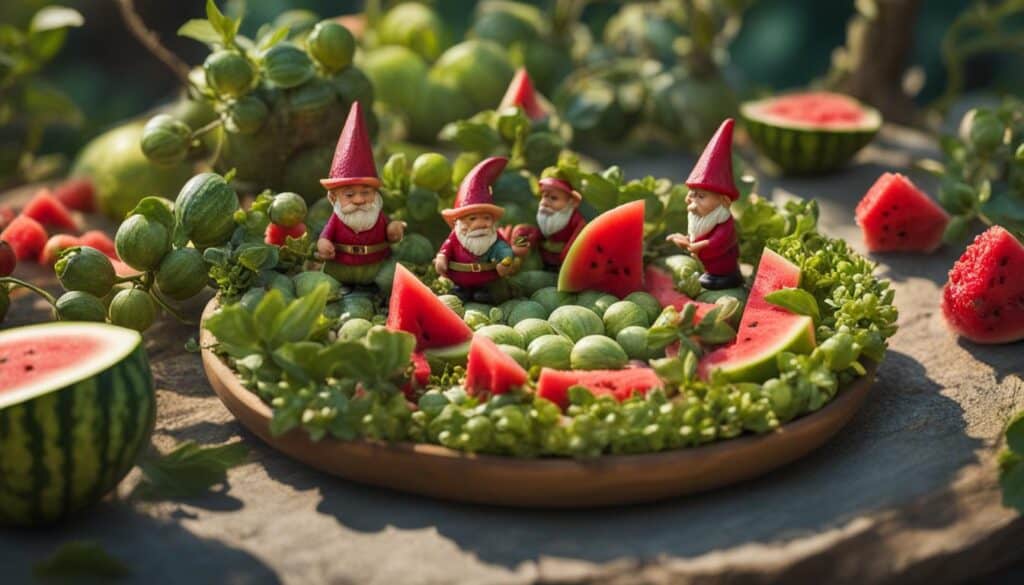
With their compact size and delicious taste, these mini melon varieties are the perfect petite fruit alternatives to watermelon. Whether you choose to grow them in containers or vertical gardens, you can enjoy the flavors and characteristics of watermelon in a smaller package. Try experimenting with different mini melon varieties to discover your favorite and add a touch of mini melon goodness to your garden or kitchen.
Growing Mini Melons: Tips and Tricks
When it comes to growing mini melons, it’s important to give these petite fruits the care and attention they need. Here are some tips and tricks to help you cultivate your own small fruit options like watermelon:
Provide Adequate Support
Even though mini melons are smaller in size, their fruits can still become heavy and cause damage to the plants. Make sure to provide proper support by using trellises or stakes. This will help the vines stay upright and prevent any potential harm.
Choose the Right Soil
Start your mini melon seeds in rich, well-drained soil. This type of soil provides the necessary nutrients for healthy plant growth and ensures proper drainage to prevent waterlogged roots. Mini melons thrive in soil with a pH level between 6.0 and 7.5.
Optimize Sunlight Exposure
Mini melons, like their larger counterparts, require full sun to reach their full potential. Ensure that your plants receive at least 6-8 hours of direct sunlight each day. If you’re growing mini melons indoors, place them near a south-facing window or provide supplemental grow lights.
Water Regularly
Consistent watering is crucial for the success of your mini melon plants. Keep the soil evenly moist, especially during hot weather. However, avoid overwatering, as it can lead to root rot. Aim to water the plants at the base, avoiding the foliage to prevent the risk of diseases.
Consider Vertical Growing
If space is limited, vertical growing techniques can maximize your mini melon harvest. Utilize trellises, cages, or other support structures to encourage upward growth. This method not only saves space but also enhances air circulation, reducing the risk of diseases.
“Vertical growing techniques can help you make the most of your limited space while cultivating mini melons.”
Prune and Train Vines
To ensure better airflow and maximize productivity, prune your mini melon vines regularly. Remove any unwanted or overcrowded branches and redirect the growth to the main stems. By training the vines, you can control their direction and encourage stronger fruit production.
Harvest at the Right Time
Mini melons are typically ready for harvest when they reach maturity, as indicated by their size and color. Refer to the specific variety’s instructions for the ideal harvesting time. Remember to be gentle when picking the fruits, especially if they’re fragile.
By following these tips and tricks, you can enjoy a fruitful harvest of mini melons that resemble watermelon in taste and appearance. Whether you have a small garden, balcony, or limited space, growing your own mini fruit options provides a rewarding and delicious experience!
Mini Melon Varieties: Size and Flavor Profiles
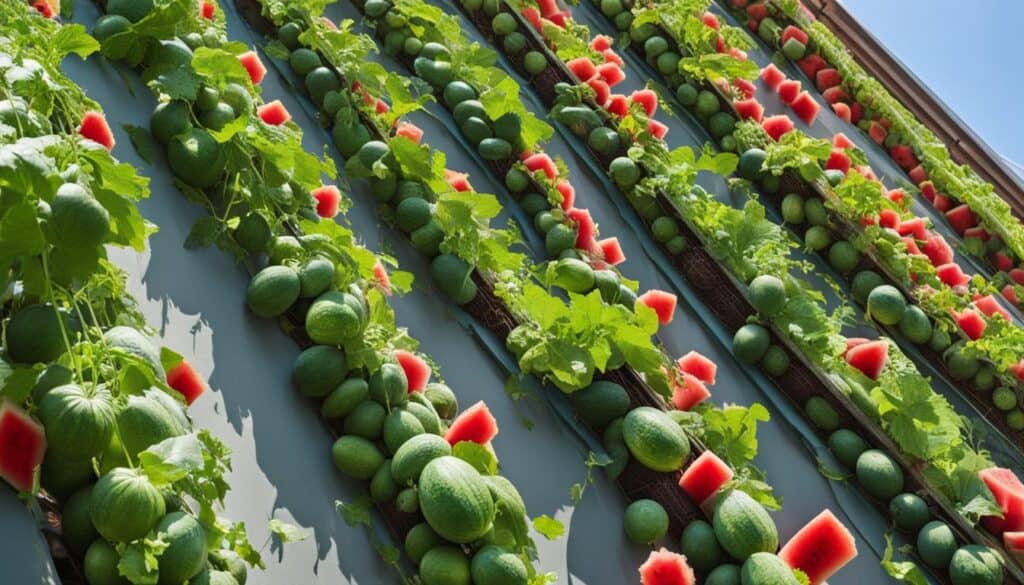
Mini melon varieties offer a delightful range of sizes and flavors, providing petite fruit alternatives that resemble watermelon. These small-sized watermelons are perfect for those craving the refreshing taste of watermelon while seeking compact fruit options.
Sprite Melon:
One variety of mini melon is the Sprite Melon, which produces fruits that are about 4 inches in size. These petite fruits have a crisp, sweet flavor reminiscent of a cross between a pear and a honeydew melon. Sprite Melon offers a unique taste profile while satisfying your watermelon cravings.
Honey Bun Cantaloupe:
Another flavorful option is the Honey Bun Cantaloupe, which yields fruits that are 5 inches in size. These mini cantaloupes have a delicious honey-flavored flesh, providing a sweet and aromatic experience with each bite.
“Delight in the crisp sweetness of Sprite Melon or indulge in the honey-flavored flesh of Honey Bun Cantaloupe.”
Super Ball Melon:
If you prefer a slightly larger mini melon, the Super Ball Melon is an excellent choice. Weighing around 1-1.5 pounds, these melons have thick, sweet white flesh. Super Ball Melon offers a satisfying size and a delightful flavor profile.
To truly appreciate the variety of mini melon options, consider growing a selection of these small fruit varieties resembling watermelon. Each variety offers a unique taste experience, allowing you to explore different flavors while indulging in the petite fruit alternatives to watermelon.
Mini Melon Size and Flavor Comparison
| Mini Melon Variety | Size | Flavor |
|---|---|---|
| Sprite Melon | Approximately 4 inches | Crisp, sweet flavor (pear and honeydew melon) |
| Honey Bun Cantaloupe | Approximately 5 inches | Delicious honey-flavored flesh |
| Super Ball Melon | Weighs around 1-1.5 pounds | Thick, sweet white flesh |
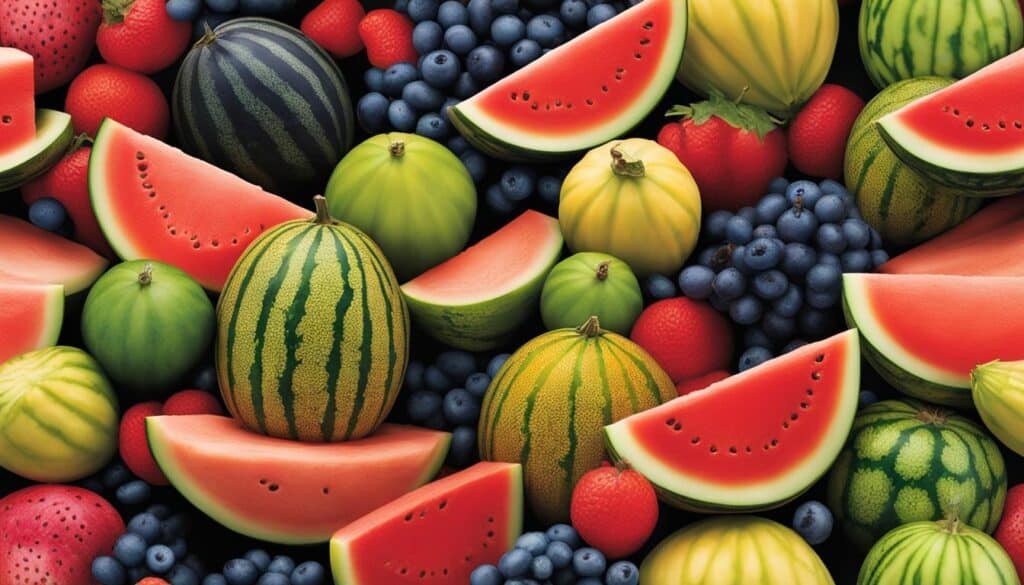
These small fruit options like mini melon varieties provide a diverse range of taste profiles while satisfying your watermelon cravings. From the crisp sweetness of Sprite Melon to the delightful honey-flavored flesh of Honey Bun Cantaloupe, each mini melon variety offers a unique flavor experience within a small-sized fruit.
More Delicious Mini Melon Varieties
There are more mini melon varieties to explore, each with its own unique characteristics. Let’s take a closer look at some of these delightful options:
Jenny Lind Cantaloupe
The Jenny Lind Cantaloupe is a sweet heirloom melon with pale green flesh. It thrives in cooler climates with shorter growing seasons, making it a perfect choice for gardeners in these areas.
Sleeping Beauty Melons
If you’re looking for the smallest mini melons, the Sleeping Beauty Melon is the ideal option. These tiny melons reach a mere half a pound in size, but don’t let their small stature fool you – they’re bursting with flavor!
Charentais Melon
Hailing from France, the Charentais Melon is a beloved heirloom variety. With its thin green/grey skin and sweet orange flesh, it offers a delightful balance of flavors that will tantalize your taste buds.
Tigger Melons
For a visually striking addition to your mini melon collection, consider Tigger Melons. These melons feature vibrant striped orange and yellow skin, with a sweet, refreshing white flesh.
| Mini Melon Variety | Characteristics |
|---|---|
| Jenny Lind Cantaloupe | Sweet pale green flesh, ideal for cooler climates |
| Sleeping Beauty Melons | Smallest mini melons, reaching only half a pound in size |
| Charentais Melon | French heirloom variety, thin green/grey skin, and sweet orange flesh |
| Tigger Melons | Visually striking with striped orange and yellow skin, and sweet white flesh |
These mini melon varieties add a diverse range of flavors and textures to your garden. Whether you’re growing them for personal enjoyment or sharing with friends and family, these small fruit options are sure to impress.
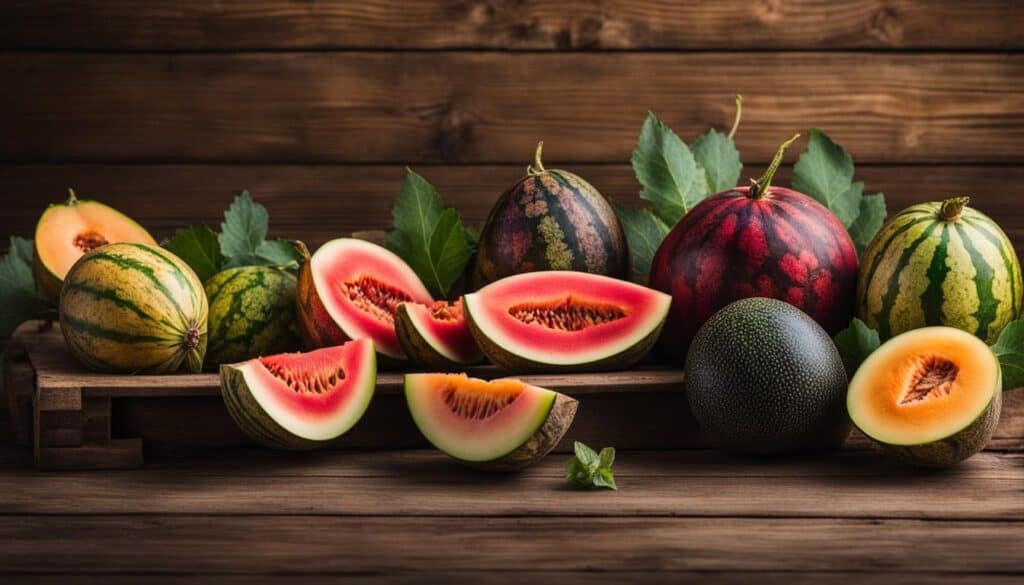
Tips for Growing Mini Melons Vertically
Growing mini melons vertically is a fantastic way to save space and create an aesthetically pleasing garden. Whether you have a small backyard, balcony, or limited garden space, vertical gardening techniques allow you to cultivate these delicious mini melons with ease.
Here are some tips for successfully growing mini melons vertically:
- Provide proper support: Use trellises or stakes to support the growing plants. Mini melon vines can become heavy with fruits, so it’s crucial to give them the necessary support to prevent damage.
- Reinforce heavy fruits: For melons that produce large and heavy fruits, consider using a melon sling or hammock to provide additional reinforcement. This will help prevent the fruits from falling off the vine and ensure they stay intact until harvest.
- Ensure full sun exposure: Mini melons, like their larger counterparts, require plenty of sunlight to grow and ripen properly. Choose a sunny spot in your garden or balcony where the plants can receive at least 6-8 hours of direct sunlight each day.
- Regular watering: Mini melons have high water requirements, especially during hot summer months. Ensure the plants receive regular watering to keep the soil consistently moist. Avoid overwatering, as it can lead to root rot.
- Consider container gardening: If you have limited outdoor space, consider growing mini melons in containers. Choose larger pots with good drainage and place them in a sunny location. Container gardening provides flexibility and allows you to move the plants if needed.
By following these tips, you can enjoy a bountiful harvest of mini melons that resemble small fruit like watermelon. Whether you’re growing them on a trellis, in containers, or along a balcony railing, vertical gardening offers a creative and efficient way to cultivate these petite fruit alternatives.
Queen Anne’s Pocket Melon: The Smallest Watermelon Variety
While there is no official world record for the smallest watermelon variety, Queen Anne’s Pocket Melon is known for consistently producing the tiniest fruits. Also known as Plum Granny Melon, this heirloom variety has an orange skin with speckled yellow stripes and a sweet fragrance. Although the taste is relatively bland, this mini watermelon is often carried in the pockets of Victorian women due to its delightful scent. Queen Anne’s Pocket Melon is a unique option for those looking for the smallest watermelon-like fruit.
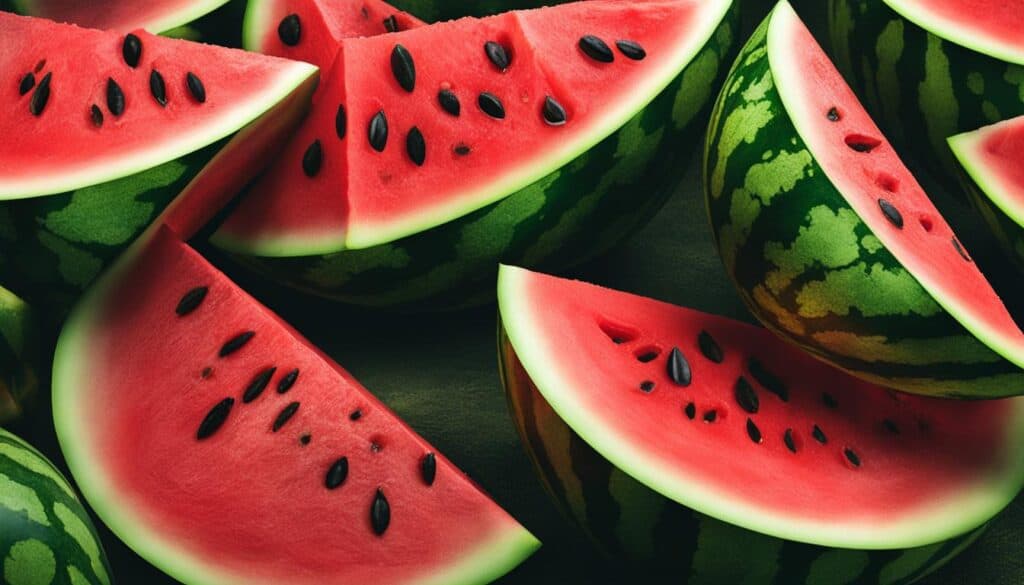
Fun Facts About Queen Anne’s Pocket Melon:
- Produces the smallest watermelon-like fruits
- Also known as Plum Granny Melon
- Orange skin with speckled yellow stripes
- Sweet fragrance
“Queen Anne’s Pocket Melon may be tiny, but its delightful scent and unique appearance make it a charming addition to any garden or fruit display.” – Gardening Enthusiast
Conclusion
If you’re craving the refreshing taste of watermelon but facing space constraints, there are plenty of small fruit options that resemble watermelon in appearance and taste. From cucamelons to various mini melon varieties, these petite fruits offer a satisfying alternative for watermelon lovers. Whether you have a small garden, balcony, or vertical growing space, you can enjoy the flavors of mini watermelon-like fruits. Cultivating these small fruit options provides a delightful experience and allows you to make the most of your limited space.
In conclusion, don’t let limited space stop you from enjoying the flavors of watermelon. Explore the world of petite fruit alternatives and discover miniature watermelon-like fruits that can satisfy your cravings. Whether it’s the refreshing crunch of cucamelons or the sweet flavors of various mini melon varieties, there are options available to suit every taste. Embrace these small fruit options and create a bountiful garden no matter the size of your space. With their petite sizes and similar characteristics to watermelon, these miniature fruits are the perfect substitutes for enjoying the summertime favorite.
So, why not try cultivating some of these small fruit alternatives today? With their adorable size and delicious flavors, you’ll never miss out on the joy of watermelon again. Whether you’re looking for petite fruit options to grow in your small garden or miniature watermelon-like fruits for your balcony oasis, there’s a perfect choice waiting for you. So, get started on your small fruit adventure and embrace the versatility and charm of these watermelon substitutes. You’ll be amazed at the abundance you can create in your limited space while savoring the taste of these delightful petite fruits!
FAQ
What are some small fruit options that resemble watermelon?
Cucamelons and various mini melon varieties are excellent alternatives to watermelon.
What is a cucamelon?
Cucamelons are grape-sized fruits that look like miniature watermelons but taste more like cucumbers with a hint of lime.
Can cucamelons be grown in containers?
Yes, cucamelons can be cultivated in containers if the climate is not ideal for outdoor growth.
What are some popular mini melon varieties?
Sprite Melon, Honey Bun Cantaloupe, Super Ball Melon, and Mini Piccolo Watermelon are some popular mini melon options.
How do I grow mini melons?
Mini melons require proper support, full sun, regular watering, and may be grown in containers or vertical gardens.
What are the size and flavor profiles of mini melon varieties?
Sprite Melon is about 4 inches in size with a sweet, pear-honeydew flavor, Honey Bun Cantaloupe is 5 inches in size with a honey-flavored flesh, and Super Ball Melon weighs around 1-1.5 pounds with thick, sweet white flesh.
What are some other mini melon varieties?
Jenny Lind Cantaloupe, Sleeping Beauty Melons, Charentais Melon, and Tigger Melons are other mini melon options with unique characteristics and flavors.
How can I grow mini melons vertically?
To grow mini melons vertically, provide proper support using trellises or stakes, and use containers for small garden spaces or balconies.
What is Queen Anne’s Pocket Melon?
Queen Anne’s Pocket Melon, also known as Plum Granny Melon, is a tiny heirloom variety with orange skin, speckled yellow stripes, and a sweet fragrance.
What are some small fruit alternatives to watermelon?
Cucamelons, various mini melon varieties, and Queen Anne’s Pocket Melon are delightful alternatives to watermelon for those with limited space.

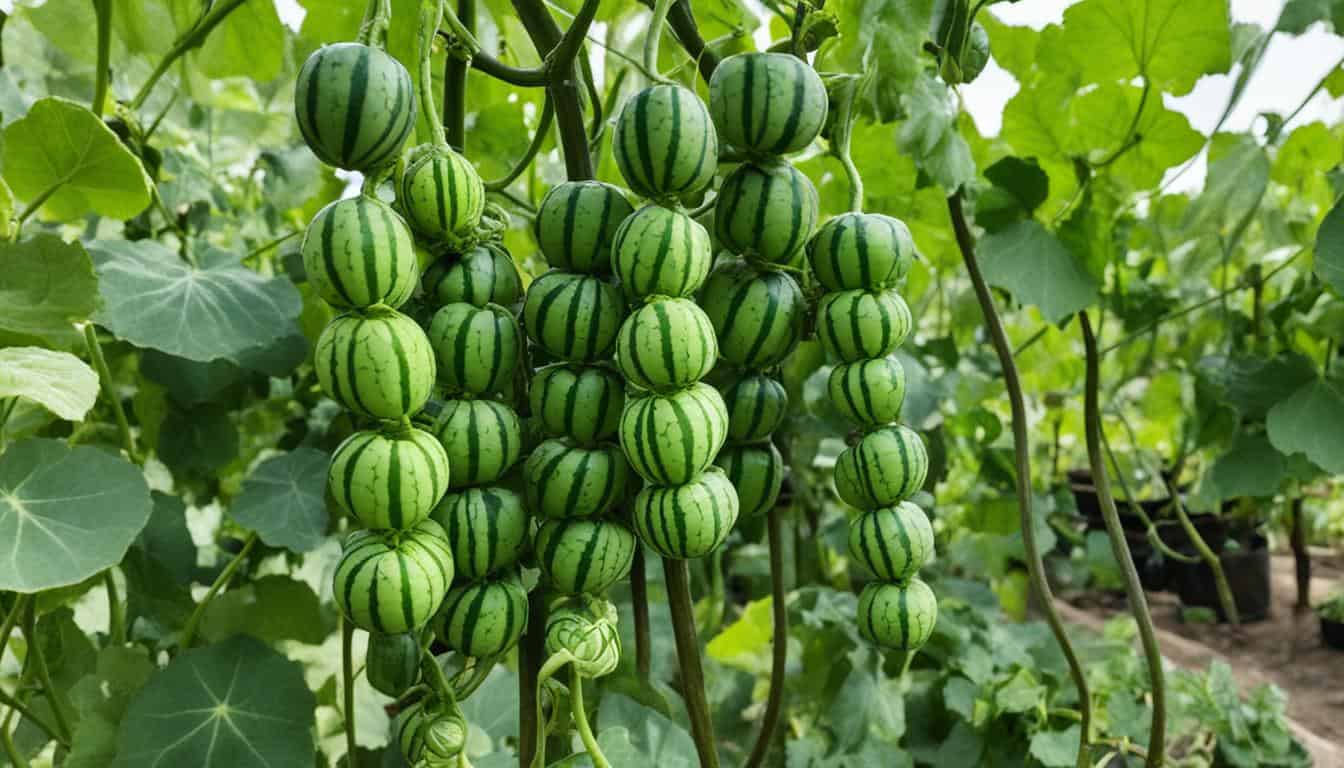



Leave a Reply